

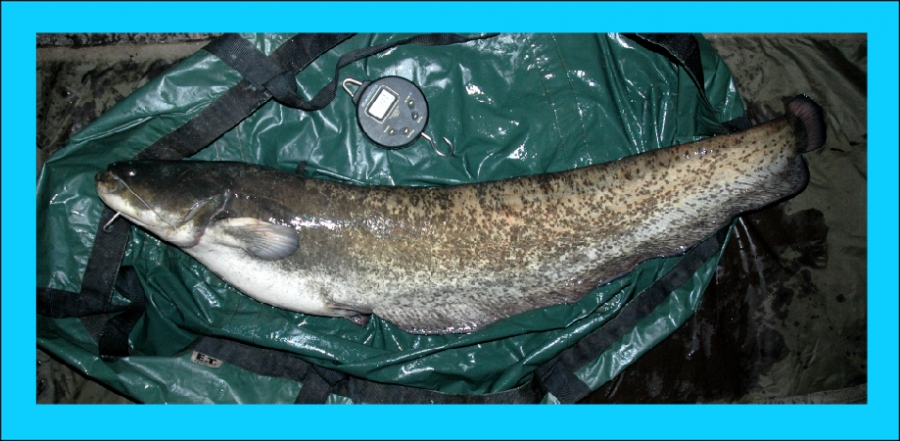
Anyone who has been lucky enough to experience the sheer power and strength of a good sized catfish will know that catfishing tackle needs to be strong and reliable - they will really test you and your gear! Even relatively small catfish will fight harder than just about anything swimming in UK waters but the key as in most forms of freshwater angling is to have correctly balanced gear - there would be little point sticking really heavy line on a little carp reel for example.
The CCG probably gets asked more questions about catfish tackle, baits and rigs than anything else. Everybody has a view and if your set-up works for you then fine but there are a few general 'rules' that you should consider when choosing your gear. It always makes sense to use equipment that is capable of dealing with the biggest fish in the venue you are fishing - there's no merit in losing any cat, so gear needs to be up-rated where very large cats are a possibility or where there are many snags.
In the early days of catting in this country most anglers came from a predator fishing background - principally pike and so their gear was usually the heaviest pike tackle they had. Today, the vast majority of anglers turning to catfish for the first time are carp anglers and will usually have a vast armoury of equipment for catching carp. Unfortunately most of it isn't really suited to catfishing!
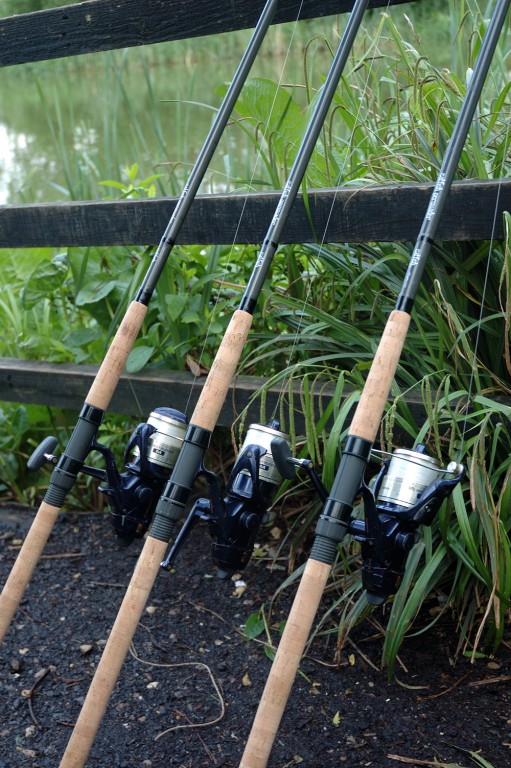 Tackle is a very personal thing so you need to choose gear that you are happy to use but it must be up to the job. Rods should be strong. These days a test curve is pretty meaningless as it doesn't take into account the rod's action. A rod rated at 3lb test with a stiff tip only action will most likely be stronger than a similarly rated rod with a through or progressive action, that said, you won't go far wrong with a rod that is rated at 3.75lb -5lb test. Catfish rods need to have a forgiving action and should bend throughout. Specialist cat rods will have a progressive action - that is they will bend further and further down the blank the more pressure is applied. There was a trend a couple of years ago to use carp 'spod rods' -mainly because they are strong and cheap. Unfortunately, most have a pretty poor action so shouldn't be considered serious catfishing weapons. Fast taper rods have no place in catfishing and stiffer rods are best avoided unless long casting is required which is pretty rare in most catfishing situations.
Tackle is a very personal thing so you need to choose gear that you are happy to use but it must be up to the job. Rods should be strong. These days a test curve is pretty meaningless as it doesn't take into account the rod's action. A rod rated at 3lb test with a stiff tip only action will most likely be stronger than a similarly rated rod with a through or progressive action, that said, you won't go far wrong with a rod that is rated at 3.75lb -5lb test. Catfish rods need to have a forgiving action and should bend throughout. Specialist cat rods will have a progressive action - that is they will bend further and further down the blank the more pressure is applied. There was a trend a couple of years ago to use carp 'spod rods' -mainly because they are strong and cheap. Unfortunately, most have a pretty poor action so shouldn't be considered serious catfishing weapons. Fast taper rods have no place in catfishing and stiffer rods are best avoided unless long casting is required which is pretty rare in most catfishing situations.
For bank fishing scenarios (which are what you will be doing 99% of the time) most anglers opt for rods with a length of 10-12 feet. A good catfish rod will have plenty of rings and even though they may be unfashionable, a 'fat' butt (if you'll pardon the expression!) is better for getting a good grip and allowing decent leverage without ending up with white knuckles and aching fingers! Perhaps the best advice for beginners dipping a toe into catting for the first time is to target small to medium sized cats on a heavily stocked water and use the heaviest pike dead baiting style rod you have until you can progress to purpose made catfish rods.
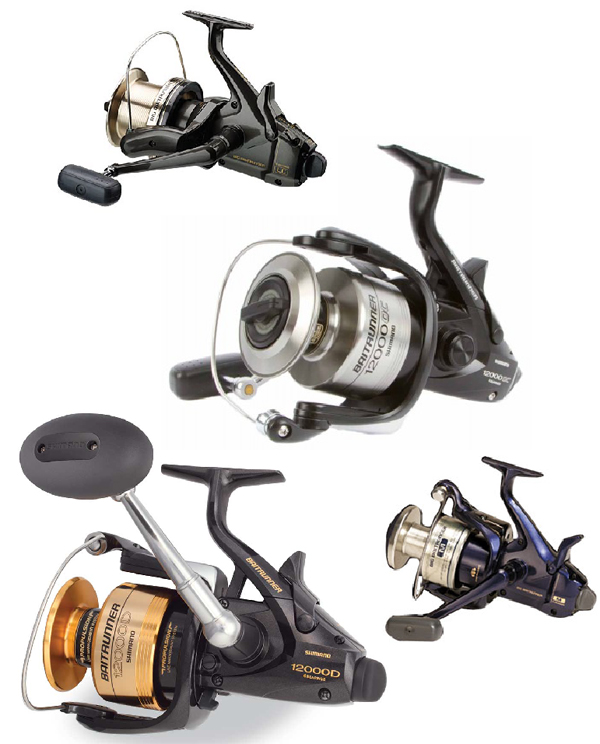
Choosing a reel for catfishing is a bit of an easier proposition. Clearly, they must be well built and strong, be capable of holding a decent amount of .40-.45mm line and have a superb clutch mechanism. Baitrunners are pretty much obligatory. Shimano D's, OC's, LC's, Big Blues and 4500/6500B's are all tried and tested models and there are plenty of similar models manufactured by other companies too.
Don't be tempted to use lighter reels or 'pretty' carp reels - they won't be up to the job. Catfish are well known for destroying carp reels and gears are easily stripped by big fish. There are times when you will need to clamp down on or slow a powerful running catfish, you cannot do this without strong equipment. For really big fish and for European catfishing, you won't beat a multiplier - Penn and Shimano make reliable models.
There is more discussion on the CCG's Forum and Facebook pages about lines for catfish than anything else! Everyone has a favourite, and that's fine but it's worth paying heed to the older and more experienced group members, - they've probably used most of them over the years! Lines fall into two main categories, mono or braid and whilst there is general agreement that mono should be around 20-30lb test and braid 80-100lb, making a choice between the two seems to divide the catting fraternity. Whilst it can be considered personal choice up to a point, there are arguments for using both according to the situation. Braids have little or no stretch so are good for tie-up situations or rigs that demand a line tight to the lead (The Cat-O-Copter for example). Mono is good in close range scenarios especially where you may be playing fish at close quarters. It is far more forgiving than braid and you stand less risk of hook pulls but as mentioned at the very beginning the important thing is to have balanced tackle -a stiff or extremely powerful rod for example fishing with braid may be good for turning a fish at long range but would be poor for playing a lively fish under the rod tip.
Lastly and importantly, don't think that braided lines are significantly more abrasion resistant than monos, they're not. Yes, braid will cut through weed and lilies like a cheese wire but pull a taught braided line over anything tougher like underwater branches or rocks and it'll snap like cotton.
The Tackle Box in Kent has been publishing fishing line test results for many years and they have kindly allowed us to reproduce their findings - Just click the link below. These are independently carried out and make interesting reading, they are principally aimed at carp anglers so the breaking strains covered are generally lighter than those that we use when catting and some of the general advice given isn't relevent to catting but they do offer a useful insight into how different brands compare and how all is not what it may seem when it comes to fishing line!
Whilst catfish don't have sharp cutting teeth like those of Pike or to a lesser extent zander, they do have very abrasive pads on both their upper and lower jaws as well as the crushing pads at the back of the throat. This means that the hook length must be both strong and abrasion resistant. Again these lines fall into two categories; braid and mono.  Catfishing is unusual in angling in that the hook link is generally a higher breaking strain than the mainline this is purely due to the abrasion resistance required.
Catfishing is unusual in angling in that the hook link is generally a higher breaking strain than the mainline this is purely due to the abrasion resistance required.
Popular Braids are Kryston, Quicksilver, Kryston Ton -Up, Catfish-Pro Catlink and Catlink XT, CatMaster Dyneema and Black Cat Power Leader but there are many others.
Monofilament hook links are especially useful on live bait rigs where their inherent stiffness can be an advantage over braid. Modern fluorocarbon lines have become the standard for many experienced catfish anglers.
Popular monofilament lines include Amnesia, Seaguar, Varivas, Tynex & Catfish-Pro Toughlink Fluoro
Problem Pike
On some waters, usually when fishing with live or deadbaits, pike can be a problem. Catfish rigs seem to attract pike, especially if rattle rigs are used. Our normal advice is to avoid fishing with these methods for catfish in waters that have bad pike infestations.
Standard catfish hooklinks are not pike proof especially braids which are cut through with ease (even heavy Kevlar is not pike proof) Fluorocarbon hook links may resist pike teeth up to a point when used at a heavy breaking strain but again can't be considered as a totally safe material. The only totally pike proof hook link is wire but this isn't catfish friendly and may cause damage to mouths and whiskers so is therefore not recommended for catfishing. Some anglers have reported success with plastic coated wire. Catfish-Pro make 'Pike Safe' which is friendly to both catfish and pike and it is also worth noting that American musky anglers regularly use Mason's Hard Mono quite successfully in the heavier gauges (80-100lb BS.)
Every angler has their favourite brands and patterns and catfish anglers are no different! The most important considerations are that the hooks you choose are both strong and sharp. Many a catfish has opened up a weak hook so choose specialist catfish patterns or hooks that have a proven record with other big fish species. The Eagle Wave hook is one of the most popular hooks in use for catfishing and that started life as a specialist tuna hook!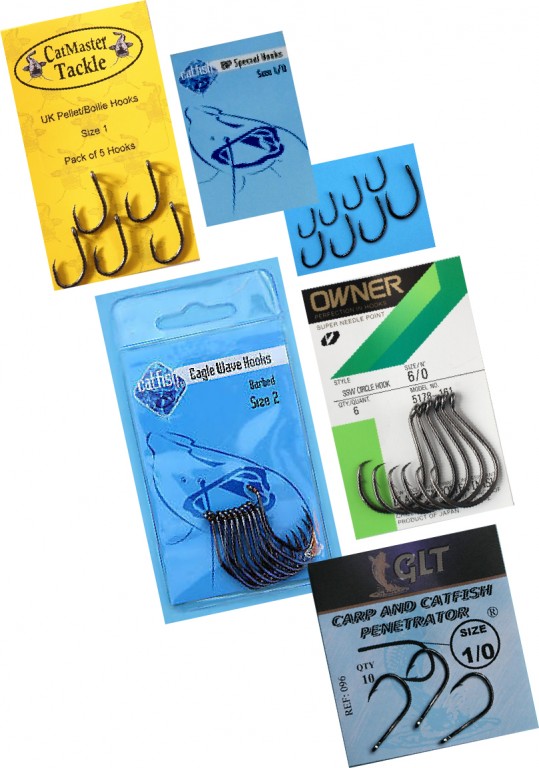
Choose your hook size carefully too. Many anglers - especially converted carpers cringe at the sizes of hook that we use for cats. To be honest, you don't need particularly large hooks to land catfish but you do need particularly large hooks when you are using particularly large baits. It is crucial that hook size matches bait size. As an example, a 1/4 or 1/2 tin of luncheon meat is a popular cat bait but would require presenting on a hook of at least size 1/0 and possibly even up to a 6/0 in some patterns, - this is not considered excessive.
Popular catfish hooks include GLT Penetrators, Eagle Waves, and Owner SSW but this list is far from exclusive - there are many more. A word of warning, don't be tempted to buy cheap unbranded hooks they are likely to be very poor quality.
For many catfish anglers, circle hooks are now pretty much standard for most live bait rigs. They look pretty extreme when viewed for the first time but don't worry about that, they will improve your hook-up rate massively as long as you remember the one rule with circles - don't strike! Owner, Gamakatsu, Catfish-Pro and VMC amongst others, all offer good patterns of circle hook. Some companies even offer hook patterns in large sizes for use with boilies and pellets such has been the influence of carp anglers on modern catfishing.
Rig Bits
All the mainstream tackle companies make useful bits and pieces that can be utilised for catfish rigs but for specialist items take a look at Catfish-Pro and CatMaster Tackle. The sort of things that most serious catfish specialists will have in their tackle boxes will be poly balls in a variety of materials and sizes, boom tube, good quality large swivels, ceramic run rings, silicon tubing and shrink tube in a range of sizes and most probably every size and shape of bead you can think of!
Most catfishers will make their own rigs but there are plenty of ready mades available if you prefer, just beware of cheap 'ready tied catfish rigs' that can be bought online, they are invariably of dubious quality using poor quality materials - stick with branded rigs and you should be fine.
In the UK at least catfish are invariably landed with a net. This needs to be both strong and large. Most anglers would consider a 50" net to be a minimum size suitable for catfish but generally a net with arms of around 60" is best. There are plenty of these on the market but not all are really designed for use with cats. Things to look for on a specialist cat net are a good strong spreader block which should have a narrow angle for the arms. A catfish net needs to be long with a much shorter draw cord than you might expect to see on a carp net for example, this is achieved by keeping the angle tight on the spreader block. The mesh should be deep and preferably not too fine - you won't be able to manoeuvre a large wet net properly unless the mesh is coarse. The handle is largely irrelevant as long as it's strong and the threaded part is well fixed to the handle itself. A nice 'stink bag' is essential!
When fishing on the Continent, whether from a boat or from the bank, a net is generally unsuitable. They are far too big and clumsy to be used in the confines of a catfishing boat and difficult if not impossible to use in even moderately flowing water. For lake fishing, you can get a net with 72" arms but these are pretty heavy and certainly not for use when fishing alone. The biggest issue (we hope!) when landing big European cats is that they are very often far too large to fit in a net. Most continental anglers would laugh at the idea of netting any catfish and the standard method is just to grip the fish's bottom jaw with a gloved hand.
On all but the lushest of soft grass, an unhooking mat of some sort will be required. Most UK fisheries require the use of a mat regardless. Catfish mats should be as large as possible, well padded and ideally have a retaining flap so they can momentarily be left unattended (whilst you are organising your weighing gear for example) without the risk of your catch slithering off. A decent unhooking mat is also invaluable for 'sliding' the catfish across the ground without risk and for easy returning. Many fisheries (who should know better!) don't seem to worry about branches, stumps, timber, scaffolding etc. sticking up around the front of swims so a well padded mat offers good protection when cats are lifted/dragged either in or out of the lake. Catfish-Pro have just introduced a very useful piece of kit called a Glide Mat, this can help with returning cats as well as offering extra protection on rough ground. Black Cat Tackle also sell a large 'ground sheet'
Most specialist catfish weigh slings are purpose made designs that take into account the fish's great length. They are often specifically shaped too as the vast majority of the cat's weight is in the front half of the fish's body. Most large and strong weigh slings will be suitable for weighing catfish but for specialist slings for very large fish look at the ones made by CatMaster, Catfish Pro and ET. Unless you are happy to get a rough weight for your captures - say to the nearest half a pound or so, then a good quality tripod is really a necessity. It is virtually impossible to get an accurate weight for a decent fish if you are just hand holding the scales. A decent weigh bar can help (especially if held by two people) and weighing poles and hooks are reasonably effective but the real answer is to use a tripod on all but the smallest fish. Nash Tackle do a good one although it is rather heavy for transporting. It is however, rated at 200lb! Cygnet Tackle make a couple of models which are nicely made although care must be taken to tighten the leg adjustment correctly as they are otherwise prone to slipping when put under pressure.

A decent sized unhooking mat and a capacious weghsling are essential pieces of kit when targetting big cats
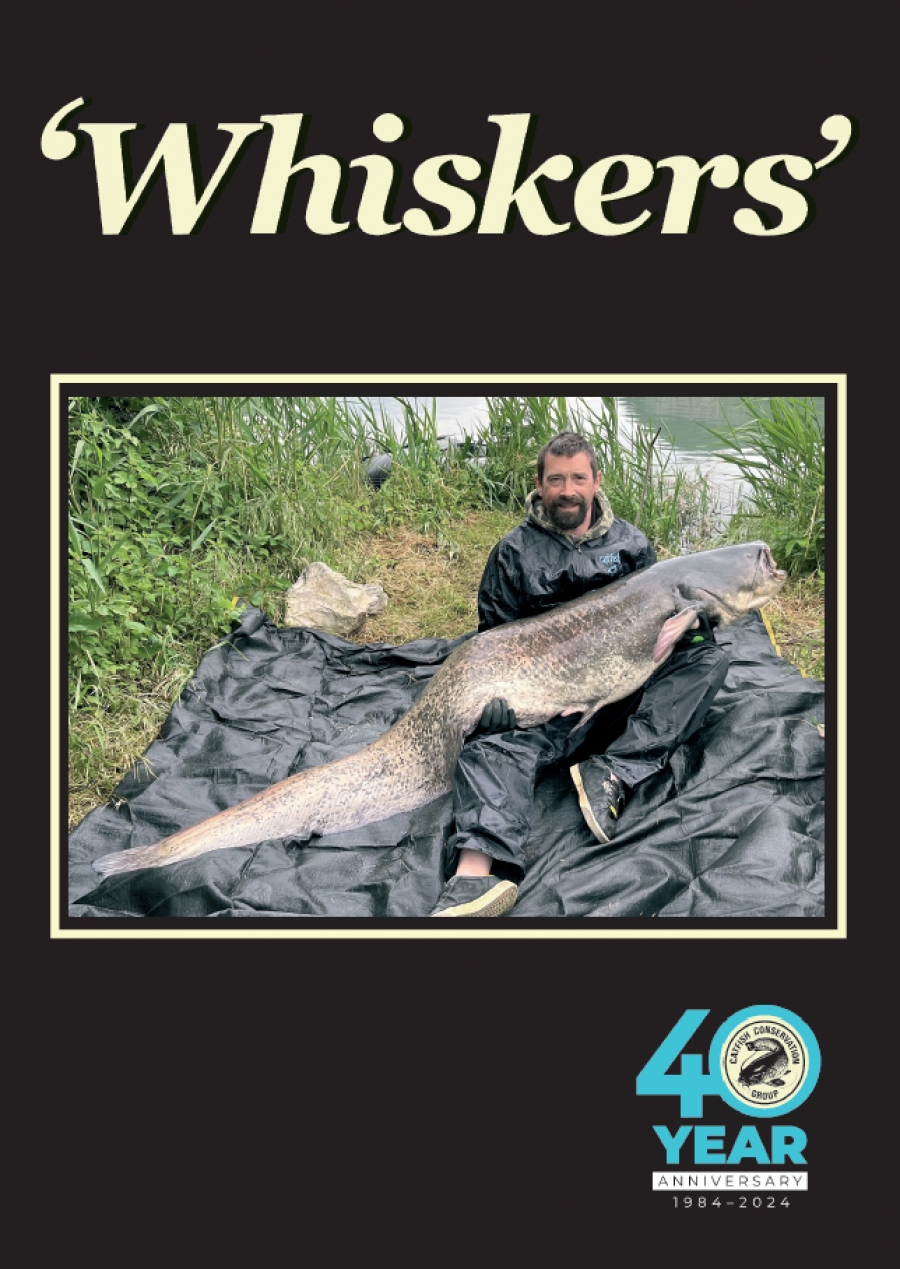
Out Now!
Whiskers magazine is Free to all members!
Non-members can purchase previous copies from the Membership Secretary